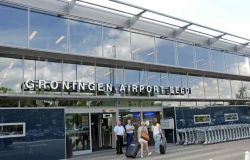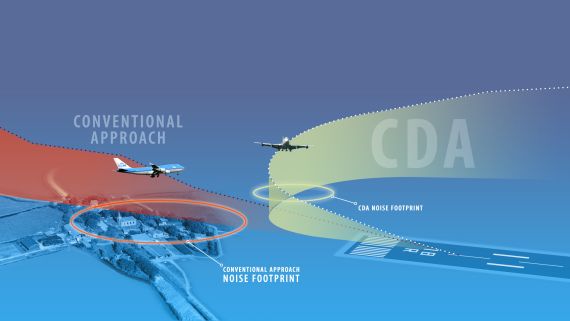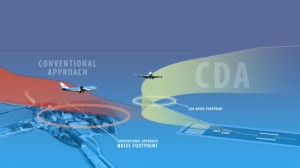On Fr iday, 17 February, Groningen Airport Eelde hosted its first gliding flight, also known as Continuous Descent Approach (CDA). The National Aerospace Laboratory (NLR) initially studied the benefits of CDAs in terms of noise, fuel consumption and exhaust emissions.
iday, 17 February, Groningen Airport Eelde hosted its first gliding flight, also known as Continuous Descent Approach (CDA). The National Aerospace Laboratory (NLR) initially studied the benefits of CDAs in terms of noise, fuel consumption and exhaust emissions.
A CDA is a landing procedure in which an aircraft approaches the airport in gliding flight mode. With a gliding flight, the aircraft flies in a less horizontal position, which saves fuel. The procedure is moreover significantly quieter, because valves and engines are less engaged, and are also used in a later stage of the landing. Moreover, the aircraft on average flies at a higher altitude. Groningen Airport Eelde is the first regional airport in the Netherlands where it is possible to use a CDA landing.
40% noise reduction
The NLR conducted a study for Groningen Airport Eeelde into the sustainability of CDAs. In this study, NLR determined the benefits of gliding flights for the types of aircraft that most commonly land at Groningen Airport Eelde. The study found that noise disturbance from approaching air traffic could be reduced by 40%. Fuel consumption can be reduced by 7%, which means lower CO2 emissions.
Transavia.com is one of the first airline companies to actively start using this new landing procedure. Groningen Airport Eelde will, moreover, also encourage all other users of the airport to adopt this procedure, in order to ensure this sustainable landing procedure is used as much as possible.
Gliding flights
At Amsterdam Airport Schiphol (AAS), gliding flights were already being performed during evening hours. NLR and Air Traffic Control the Netherlands (NVNL) researched the possibilities of extending these flights for AAS.




